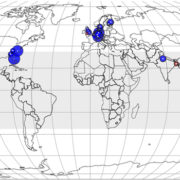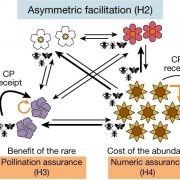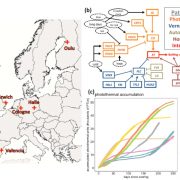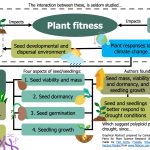Individualistic responses of forest herb traits to environmental change ($) (Plant Biol)
 Functional traits have shown promise for their ability to improve predictions of interspecific plant responses to environmental factors, but most trait-based studies have not addressed the role of intraspecific trait variation (ITV) in trait-environment relationships. ITV may be directly or indirectly altered by climate change pressures and land use histories, depending on individual levels of phenotypic plasticity. Blondeel et al. use a factorial manipulative experiment to test changes in mean plant height and mean specific leaf area (SLA) within 15 different plant species from temperate European forests in response to warming with open-top chambers, fluorescent light addition, and nitrogen addition. Community members were diversified to include a range of levels of forest (shade) adaptation and colonization ability and soils had different agricultural use histories. ITV responses to treatments were variable and dependent on species but some patterns did emerge. This study found that mean plant height increased within species in response to more available light, warming, and agricultural land-use due largely to enhanced vegetative cover. The mean plant height of fast-colonizers increased the most in response to treatments. These results highlight the potential importance of the indirect effects of climate change and land use history in the form of increased competition and a shift towards fast growing and colonizing species. Surprisingly, there were no interactive effects of treatments on ITV and mean SLA experienced species-dependent bidirectional change with few strong patterns emerging in response to treatments. (Summary by Sienna Wessel) Plant Biology 10.1111/plb.13103
Functional traits have shown promise for their ability to improve predictions of interspecific plant responses to environmental factors, but most trait-based studies have not addressed the role of intraspecific trait variation (ITV) in trait-environment relationships. ITV may be directly or indirectly altered by climate change pressures and land use histories, depending on individual levels of phenotypic plasticity. Blondeel et al. use a factorial manipulative experiment to test changes in mean plant height and mean specific leaf area (SLA) within 15 different plant species from temperate European forests in response to warming with open-top chambers, fluorescent light addition, and nitrogen addition. Community members were diversified to include a range of levels of forest (shade) adaptation and colonization ability and soils had different agricultural use histories. ITV responses to treatments were variable and dependent on species but some patterns did emerge. This study found that mean plant height increased within species in response to more available light, warming, and agricultural land-use due largely to enhanced vegetative cover. The mean plant height of fast-colonizers increased the most in response to treatments. These results highlight the potential importance of the indirect effects of climate change and land use history in the form of increased competition and a shift towards fast growing and colonizing species. Surprisingly, there were no interactive effects of treatments on ITV and mean SLA experienced species-dependent bidirectional change with few strong patterns emerging in response to treatments. (Summary by Sienna Wessel) Plant Biology 10.1111/plb.13103
[altmetric doi=”10.1111/plb.13103″ details=”right” float=”right”]









